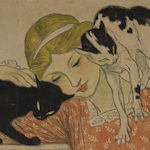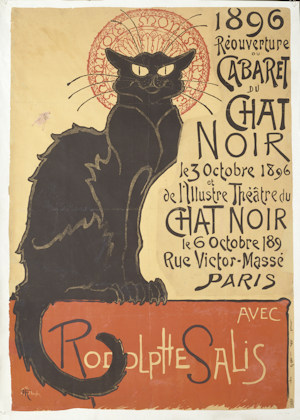
Put away the book, slip those dancing feet into something more comfortable, grab your coat, and pop over to Belvedere’s Into the Night exhibition to celebrate the artistic legacy of clubs and cabarets.
- Explore the modern art created and inspired by venues across eight decades and several continents
- Works include those by the likes of Arp, Dix, Toulouse-Lautrec, Prince Twins Seven Seven, and other international artists
- Also features an astonishing reconstruction of the bar at Kabarett Fledermaus
- Runs Feb 14 – Jun 1, 2020
- All display information is in English, too
- See also:
- Current Belvedere info & overview
- Current exhibition listings
Cabarets and clubs in modern art

(Théophile-Alexandre Steinlen, Réouverture du Cabaret du Chat Noir, 1896, © Victoria and Albert Museum, London)
One of the more iconic images of France is the black cat on posters associated with the Chat Noir cabaret of 19th-century Paris. Now there’s a picture that conjures up smoke-filled rooms, top-hatted patrons, the satisfying sting of cognac, and the teasing cries of the performers. (All of which might just be my imagination).
The point is that the poster inspired by the club has left an indelible impression on art and cultural history. Which brings us nicely to Belvedere’s Into the Night exhibition, which celebrates exactly that: the influence of cabarets, clubs, cafés, and similar on various forms of modern art.
Curator, Florence Ostende, takes a handful of locations from around the world and demonstrates how they provided a platform for new ideas and trends, driving inspiration and inventiveness within their walls.
Each location gets a section to itself, with most in the Lower Belvedere Palace and four in the attached Orangery gallery. Exhibits and text then explain and illustrate, for example:
- The art represented by the venue itself, such as Café L’Aubette‘s abstract architecture of the 1920s
- The art created at the venue, such as promotional posters or performances (like those of modern dance pioneer, Loïe Fuller, at Folies-Bergère in the 1890s)
- The art inspired by the venue, such as Jacob Lawrence’s 1951 work, Vaudeville, inspired by what he saw during the Harlem Renaissance
Art here is used in its widest context: a pot pourri of music, literature, dance, design, and the graphic arts…all made possible by an avant garde atmosphere redolent with the radical thinking and innovation that these venues encouraged.
The clubs covered span various eras and regions, from late 19th-century Paris, through turn-of-the century Vienna and 1920s Rome and New York, to 1960s Tehran and Ibadan.
Artists featured in the 300+ works exhibited include such resonant local names as Hoffmann and Kokoschka, but also international artists like Toulouse-Lautrec, Henri Rivière, Jean (Hans) Arp, Hannah Höch, or Prince Twins Seven Seven.
The highlights
That famous Chat Noir poster is the first thing you see, but the very last exhibit (right at the back of the Orangery) is the one that leaves the biggest impression.
The reconstruction of the Kabarett Fledermaus bar from 1907 Vienna features over 7000 mosaic tiles and a cocktail of colour that no drink could ever hope to match. We can thank the University of Applied Arts Vienna for the implementation.
Fans of Vienna modernism can also enjoy a few mementos of the time, from a Josef Hoffmann ashtray to a poster by Fritz Lang.
My other personal highlights include:

(Exhibition view INTO THE NIGHT Photo: Johannes Stoll / Belvedere, Vienna)
- The 1934 map of Harlem nightclubs by cartoonist E. Simms Campbell, with such annotations as (for Club Hot Cha) “…nothing happens before 2am. Ask for Clarence.”
- The shadows projected by zinc silhouettes, illustrating the shadow theatre created by Henri Rivière at the Chat Noir
- Henri de Toulouse-Lautrec’s 1893 series of lithographs of Ms Fuller in mid-flight, so to speak; a transformation of shape and colour
- Fortunato Depero’s 1922 Dance of the Devils tapestry from Rome’s Cabaret del Diavolo
- Reconstructions of the striking wall silhouettes and sculpted facade from Nigeria’s Mbari Mbayo and Mbari Artists and Writers Club
Dates, tickets & tips
A collaboration with London’s Barbican Centre, the exhibition runs from February 14th to June 1st, 2020. Just grab a normal entrance ticket for Lower Belvedere or use a Vienna Pass (see my review).
How to get to the exhibition
Unlike normal exhibitions at Belvedere, Into the Night spans two locations: the Lower Belvedere palace building itself and the orangery just outside. Find directions on this page.
Address: Rennweg 6, 1030 Vienna